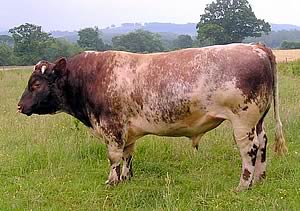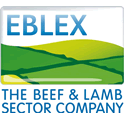2009-07-30
The Upsall herd near Thirsk, in Yorkshire, owned by Gerald Turton and managed by stockman Laurence Fenton, has been recognised by EBLEX as the Most Improved Herd for the Beef Shorthorn breed for 2008/09.
Upsall Beef Shorthorn Stock Bull - Vortrekker
 |
The Upsall herd near Thirsk, in Yorkshire, owned by Gerald Turton and managed by stockman Laurence Fenton, has been recognised by EBLEX as the Most Improved Herd for the Beef Shorthorn breed for 2008/09.
The award is presented by the EBLEX Beef Better Returns Programme (Beef BRP), to the recorded herd that shows the greatest genetic gain for commercial traits over a 12-month period. There is a separate award for each of ten UK breeds.
The Turton family, including Gerald Turton’s son Robin, has been farming on the Upsall and Roxby Estate for four generations, and the herd is celebrating its centenary this year. In September, there is to be a reduction sale of 70 females to celebrate the 100th anniversary.
The farm runs to 408ha (1000 acres). Nearly three-quarters is down to arable crops, with the rest permanent pasture for the 80 pedigree Beef Shorthorn cows to graze.
Mr Turton has been farming at Upsall since 1959 and began attending the Perth Bull Sales in the 1960s. He has always been interested in recording performance and first started weighing animals in the 1970s. He is now involved in DNA testing looking at ways to prevent disease.
In the 2001 Foot and Mouth Disease outbreak, livestock were culled right up to the farm boundary – but strong will and good fortune saved the herd, which includes some rare bloodlines.
Three British-bred bulls – Loch Awe Lysander, Supreme Champion at Perth Bull Sales in 1998, Uppermill Recto, sire of supreme champions at Perth, and homebred Vortrekker of Upsall – have taken the herd forward over the past decade in terms of genetics for growth. Now semen imported from Canada and Australia is being brought in to improve carcass traits such as eye muscle depth. Breeding rights have been acquired for a fixed period from an Australian bull with outstanding Estimated Breeding Values (EBVs) for these traits.
When deciding which females to keep for breeding, Mr Turton looks at a combination of EBVs, type and family lines.
“EBVs are very useful in the selection process; I wouldn’t even bother looking at a bull if he didn’t have figures to back up his looks. With them, I feel armed with the best possible information to make the right selections for the herd,” explains Mr Turton. “Having them also means I can also give very real assurance to the people who buy cattle from me that they will perform in the future.”
Calving takes place mostly indoors in spring, with calves turned out as soon as possible. Weaning takes place in late October/early November at housing. Bulls and heifers are separated when they are weighed at 200 days of age. All are fed a forage diet – based on grazed grass in summer and silage in winter.
Females are retained or sold to other breeders – either through Perth sales or at sales held on the farm. Most of the bull calves are kept entire and sold to pedigree breeders or commercial producers looking for an easy calving breed, or are finished at 17 months of age at 600kg.
Recently, Mr Turton has started to cut some of the bulls and finish them as steers, making them eligible for the Yorkshire Beef Shorthorn Scheme. The scheme pays a premium over market price for qualifying animals and has been established under the Farexchange Yorkshire Programme, of which EBLEX is a member.
Some of these are sold through a high class farm shop based in Harrogate, which specialises in offering meat from traditional breeds. Andrew Loftus, the shop’s managing director, particularly likes the Beef Shorthorn.
“Cattle of this breed are good grazers and great convertors of grass into meat – which makes the taste a far better experience for the consumer, which adds value to the product,” says Mr Loftus.
“The fact that the Beef Shorthorn is the oldest recorded pedigree breed in the world, and originates from Yorkshire, is a story that quickly gains the consumers’ attention and becomes a unique selling point.
“I welcome the fact that Gerald takes performance-recording so seriously and is trying to achieve an end product that we are looking for with a traditional breed.”
EBLEX breeding specialist Samuel Boon also agrees.
“EBVs are measurements of genetic potential and provide a reliable insight into the effect a bull can have on a herd,” says Mr Boon. “It means producers can make informed purchasing decisions rather than leaving it to chance, and hoping the chosen animal will deliver on the commercially important traits.
“All the winners of the Improved Herd Awards record the performance of their herds. All are providing valuable information that can help customers produce animals that make them money because they meet producer, processor, retailer and consumer demand, and do so as efficiently as possible.
“I congratulate Gerald Turton and Laurence Fenton on the excellent job they are doing with the Upsall herd.”
 Beef Shorthorn - a cattle breed for the future Beef Shorthorn - a cattle breed for the future
 Andreayas Herd Wins EBLEX Award for British Blue Breed Andreayas Herd Wins EBLEX Award for British Blue Breed
 Westwilmer Herd Wins EBLEX Award for Aberdeen Angus Breed Westwilmer Herd Wins EBLEX Award for Aberdeen Angus Breed
 Elmtree Herd Wins Most Improved Award for Limousin Breed Elmtree Herd Wins Most Improved Award for Limousin Breed
|



